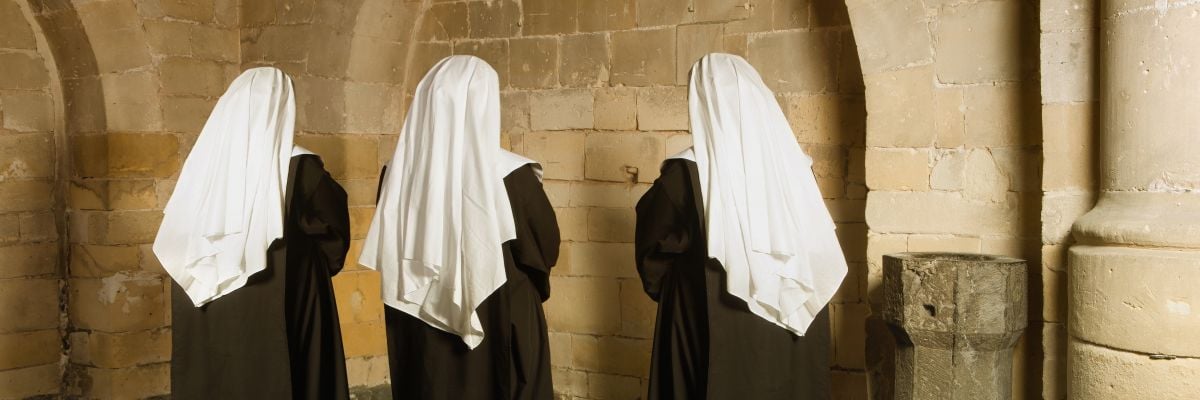
As Christians living in the world, we are called to perform works of mercy, giving of ourselves for the sake of those who have less: feeding the hungry, visiting the imprisoned, clothing the naked. There are even some who feel that this is the extent of the Christian life and thus have trouble understanding the call of cloistered religious—those who are enclosed in a monastery to pray, work, and offer sacrifices.
But the cloistered life has deep historical and scriptural roots. The first contemplative, cloistered communities go back to at least the fourth century, when Christians had begun to make their way out into the desert in order to find solitude in which they could pray. The work of these communities is effective and profound. While others are out in the world, these men and women are praying, working, and making sacrifices for the good of the Church and the world.
The term cloister comes from the Latin clausura (from claudere, “to shut up”). It refers to an enclosed space and is typically used in the context of enclosure for religious purposes. There are many religious communities that are cloistered, and their reasons for this way of life are many.
The Church recognizes three distinct types of cloisters. A papal cloister is considered the strictest form. The cloistered monk or nun does not leave the monastery, with few exceptions, and these exceptions are granted only in very serious circumstances. The name comes from the fact that the rules for such cloisters come directly from Rome. Some examples of religious orders adhering to the papal cloister are the Carmelites and the Poor Clares.
Another type is the constitutional cloister. In general, it is less strict than the papal cloister, although these practices vary greatly, as the norms and rules for constitutional cloister come from the particular religious order’s constitutions and rule (hence the name). Typically, constitutional cloisters would be those orders that are contemplative but involved in some sort of apostolic or charitable work that would necessitate more flexibility and freedom to leave the cloister. The Norbertines (or Praemonstratensians) and the Passionists would be examples of religious orders governed by a constitutional cloister.
A third type is the monastic cloister, which is very similar to the constitutional cloister. In this case, guests may even be invited to stay at the monastery, and interaction with visitors is much more free and open as compared to the papal cloister. The Benedictines and the Cistercians would be well-known examples of the monastic cloister.
The prayers of religious communities are effective and accomplish great work for the Church. In Vultum Dei quaerere, his apostolic constitution on women’s contemplative life, Pope Francis wrote, “How much has the apostolate been enriched by the prayers and sacrifices radiating from monasteries! And how great is the joy and prophecy proclaimed to the world by the silence of the cloister!”(5).
Many cloistered orders have an online presence, even on social media, and utilize new technologies and digital media to engage with the world from within the cloister. To a certain extent, there is nothing wrong with this; but there is a danger of taking it too far, as Pope Francis cautions:
I urge a prudent discernment aimed at ensuring that they remain truly at the service of formation to contemplative life and necessary communication, and do not become occasions for wasting time or escaping from the demands of fraternal life in community. Nor should they prove harmful for your vocation or become an obstacle to your life wholly dedicated to contemplation (34).
In other words, an online presence should not be treated as a loophole that allows one to “live” outside the cloister.
But why be cloistered in the first place? Some may say that these cloistered women and men should be out in the world, witnessing for the Church, working in hospitals, schools, parishes, soup kitchens, etc. What’s the point of locking yourself up to pray? they may ask.
It is a mistake to think of the cloister as an escape from the world, or a retreat, in the sense of a defeat. Rather, the cloister makes the individual free to devote himself completely to prayer and sacrifice for the Church and the world.
When they go into seclusion to dedicate themselves to prayer, cloistered religious orders (and hermits) are following the example of Jesus. There are many times throughout the Gospels that we are told that Jesus either went off by himself to pray or encouraged others to do so.
We read that “in the morning, a great while before day, he rose and went out to a lonely place, and there he prayed” (Mark 1:35). Later in the same Gospel, we hear: “And after he had taken leave of them, he went up into the hills to pray” (6:46).
Luke tells us, “In these days he went out into the hills to pray; and all night he continued in prayer to God” (6:12). And also: “Now it happened that as he was praying alone the disciples were with him” (9:18).
Of course, Jesus does not only pray in seclusion. There are times that he takes some of his apostles with him, praying in community, but in a place set aside. For example, just prior to the Transfiguration, “Now about eight days after these sayings he took with him Peter and John and James, and went up on the mountain to pray” (Luke 9:28).
Perhaps the best-known example happened the night before Jesus was crucified. He was with his apostles in the Garden of Gethsemane, in great distress, and repeatedly went off by himself to pray. At various points in this narrative, we hear Jesus say, “Sit here, while I go yonder and pray,” and we are told that “going a little farther he fell on his face and prayed” and “Again, for the second time, he went away and prayed” and “So, leaving them again, he went away and prayed for the third time, saying the same words” (cf. Matthew 26:35-46, Mark 14:32-41, Luke 22:39-46).
Not only does Jesus set the example for cloistered prayer in a place set away from the world, he commands us to follow his example.
And when you pray, you must not be like the hypocrites; for they love to stand and pray in the synagogues and at the street corners, that they may be seen by men. Truly, I say to you, they have their reward. But when you pray, go into your room and shut the door and pray to your Father who is in secret; and your Father who sees in secret will reward you (Matt. 6:5-6).
Following the example of Jesus, and in the footsteps of centuries of cloistered religious who came before them, many of today’s cloistered orders are growing and continue to do their joy-filled work for the Church and the world.



